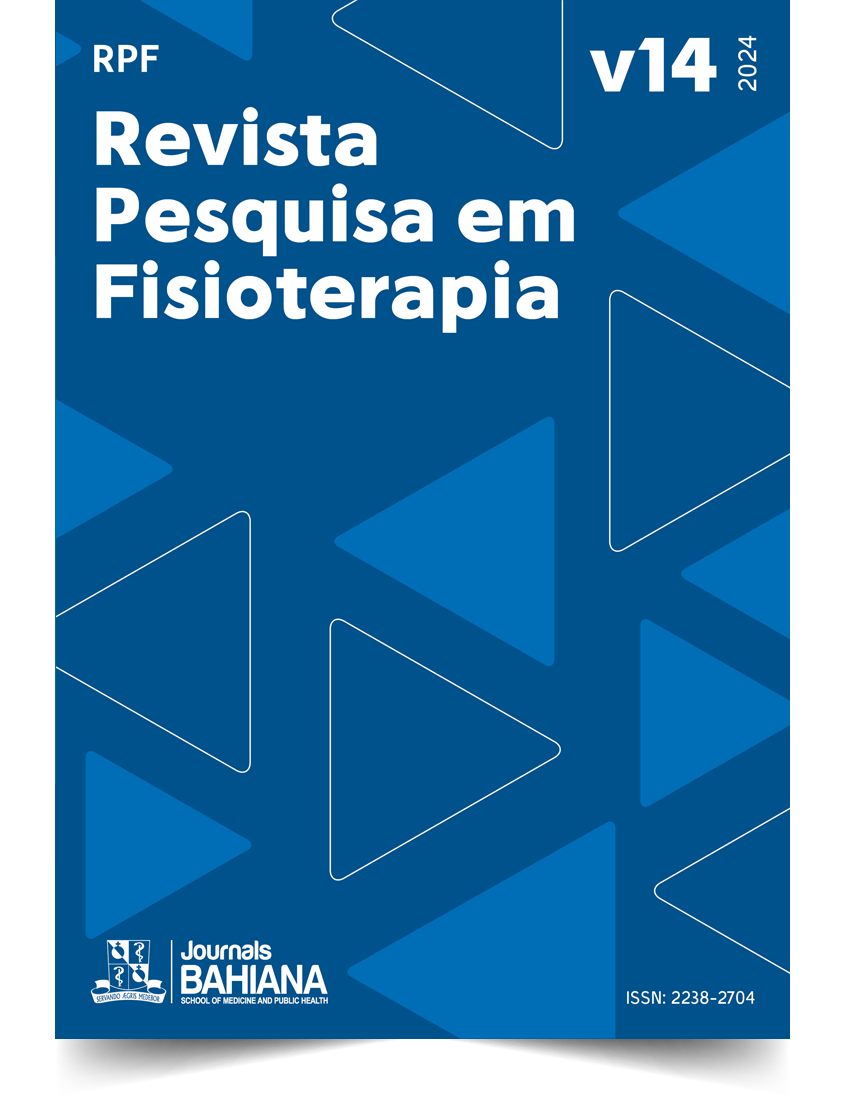Efeitos do campo eletromagnético pulsado e do retrowalking em pacientes com dor lombar crônica inespecífica: um estudo piloto
DOI:
https://doi.org/10.17267/2238-2704rpf.2024.e5608Palavras-chave:
Campos Eletromagnéticos, Dor Lombar, Cinesiofobia, Ensaio ClínicoResumo
INTRODUÇÃO: A dor lombar crônica inespecífica (DLCI) é uma condição importante em todo o mundo que tem graves consequências emocionais, sociais e econômicas. O gerenciamento é difícil, exigindo o desenvolvimento de abordagens novas, eficazes e seguras. OBJETIVOS: Este estudo foi realizado para examinar os efeitos dos Campos Eletromagnéticos Pulsados (CEMP) e do retrowalking sobre a dor, a incapacidade, a mobilidade da coluna vertebral, a rigidez dos isquiotibiais, o equilíbrio e a cinesiofobia em pacientes com dor lombar crônica não específica. MATERIAIS E MÉTODOS: Os participantes (n=48) com DLCI crônica foram divididos aleatoriamente em quatro grupos: Grupo A: Grupo convencional, Grupo B: Grupo CEMP, Grupo C: Grupo retrowalking e Grupo D: Grupo CEMP e retrowalking. As intervenções foram realizadas três vezes por semana durante seis semanas. Os resultados foram dor, incapacidade, tensão nos isquiotibiais, equilíbrio, mobilidade da coluna vertebral e cinesiofobia, medidos na linha de base e após seis semanas. RESULTADOS: O resultado sugeriu uma melhora significativa na dor, na incapacidade, na tensão dos isquiotibiais, na cinesiofobia e no equilíbrio. Entretanto, não foi observada melhora significativa na mobilidade da coluna vertebral (flexão e extensão da ADM) quando a comparação entre os grupos foi feita na sexta semana. A melhora máxima foi observada no grupo D, seguida pelo grupo C e pelo grupo B, em comparação com o grupo A. CONCLUSÃO: Pode-se concluir que a CEMP e o retrowalking, quando administrados em combinação, diminuem significativamente a dor, a incapacidade, a rigidez dos isquiotibiais, a cinesiofobia e melhoram o equilíbrio dos pacientes com dor crônica não espinhal.
Downloads
Referências
(1) Fatoye F, Gebrye T, Ryan CG, Useh U, Mbada C. Global and regional estimates of clinical and economic burden of low back pain in high-income countries: a systematic review and meta-analysis. Front Public Health. 2023;11:1098100. https://doi.org/10.3389/fpubh.2023.1098100
(2) Mattiuzzi C, Lippi G, Bovo C. Current epidemiology of low back pain. Journal of Hospital Management and Health Policy. 2020;4. https://doi.org/10.21037/jhmhp-20-17
(3) O'Keeffe M, Ferreira GE, Harris IA, Darlow B, Buchbinder R, Traeger AC, et al. Effect of diagnostic labelling on management intentions for Non‐Specific low back pain: A randomized Scenario‐Based experiment. European Journal of Pain. 2022;26(7):1532-45. https://doi.org/10.1002/ejp.1981
(4) Rahman NAA, Li S, Schmid S, Shaharudin S. Biomechanical factors associated with non-specific low back pain in adults: A systematic review. Physical Therapy in Sport. 2023;59:60-72. https://doi.org/10.1016/j.ptsp.2022.11.011
(5) Joshi S, Singh SK, Vij JS. Effect of Retrowalking, a Non-Pharmacological Treatment on Pain, Disability, Balance and Gait in Knee Osteoarthritis: A Randomized Controlled Trial. Indian Journal of Public Health Research & Development. 2019;10(2):214-219. http://doi.org/10.5958/0976-5506.2019.00288.2
(6) Sharma S, Joshi S. Potential Use of Pulsed Electromagnetic Field in Musculoskeletal Disorders: A Narrative Review. Journal of the Dow University of Health Sciences. 2024;18(1). https://doi.org/10.36570/jduhs.2024.1.1703
(7) Karnati VNP, Reddy SK. Core Stabilization Program and Conventional Exercises in the Patients with Low Back Pain-A Comparative Study. International Journal of Physiotherapy. 2015;2(1):352-60. https://doi.org/10.15621/ijphy/2015/v2i1/60041
(8) Hodges PW, Richardson CA. Altered trunk muscle recruitment in people with low back pain with upper limb movement at different speeds. Archives of physical medicine and rehabilitation. 1999;80(9):1005-12. https://doi.org/10.1016/s0003-9993(99)90052-7
(9) Eldridge SM, Chan CL, Campbell MJ, Bond CM, Hopewell S, Thabane L, et al. CONSORT 2010 statement: extension to randomised pilot and feasibility trials. BMJ. 2016;355. https://doi.org/10.1136/bmj.i5239
(10) Julious SA. Sample size of 12 per group rule of thumb for a pilot study. Pharmaceutical Statistics: The Journal of Applied Statistics in the Pharmaceutical Industry. 2005;4(4):287-91. https://doi.org/10.1002/pst.185
(11) Su DB, Zhao ZX, Yin DC, Ye YJ. Promising application of pulsed electromagnetic fields on tissue repair and regeneration. Prog Biophys Mol Biol. 2024;187:36-50. https://doi.org/10.1016/j.pbiomolbio.2024.01.003
(12) Raza T, Riaz S, Ahmad F, Shehzadi I, Ijaz N, Ali S. Investigating the Effects of Retro Walking on Pain, Physical Function, and Flexibility in Chronic Non-specific Low Back Pain. Iranian Rehabilitation Journal. 2023;21(2):309-18. https://doi.org/10.32598/irj.21.2.1880.1
(13) Whitley CR, Dufek JS. The Effect Of Retro Locomotion On Flexibility Of The Low Back And Hamstrings. Medicine & Science in Sports & Exercise. 2009;41(5):358. http://dx.doi.org/10.1249/01.MSS.0000355640.23833.8b
(14) Ansari S, Raza S, Bhati P. Impact of retrowalking on pain, range of motion, muscle fatigability, and balance in collegiate athletes with chronic mechanical low back pain. Sport Sci Health. 2021;17:307-16. https://doi.org/10.1007/s11332-020-00682-y
(15) Parikh PR, Desai DS. Effectiveness of Forward Walking Versus Retro Walking on Balance, Gait Speed and Lower Body Functional Strength among the Elderly Population-A Comparative Study. International Journal of Health Sciences and Research. 2022;12(4):283-91. https://doi.org/10.52403/ijhsr.20220433
(16) Woby SR, Roach NK, Urmston M, Watson PJ. The relation between cognitive factors and levels of pain and disability in chronic low back pain patients presenting for physiotherapy. European journal of pain. 2007;11(8):869-77. https://doi.org/10.1016/j.ejpain.2007.01.005
(17) Zagyapan R, Iyem C, Kurkcuoglu A, Pelin C, Tekindal MA. The relationship between balance, muscles, and anthropomorphic features in young adults. Anat Res Int. 2012;2012:146063. https://doi.org/10.1155/2012/146063
(18) Endo Y, Sakamoto M. Relationship between lower extremity tightness and star excursion balance test performance in junior high school baseball players. J Phys Ther Sci. 2014;26(5):661-3. https://doi.org/10.1589/jpts.26.661
(19) Fritz JM, George SZ, Delitto A. The role of fear-avoidance beliefs in acute low back pain: relationships with current and future disability and work status. Pain. 2001;94(1):7-15. https://doi.org/10.1016/S0304-3959(01)00333-5
(20) Atya AM. The validity of spinal mobility for prediction of functional disability in male patients with low back pain. Journal of Advanced Research. 2013;4(1):43-9. https://doi.org/10.1016/j.jare.2012.01.002
Downloads
Publicado
Edição
Seção
Licença
Copyright (c) 2024 Sujata Sharma, Shabnam Joshi

Este trabalho está licenciado sob uma licença Creative Commons Attribution 4.0 International License.
Esta obra está licenciada com uma Licença Creative Commons Atribuição 4.0 Internacional.



